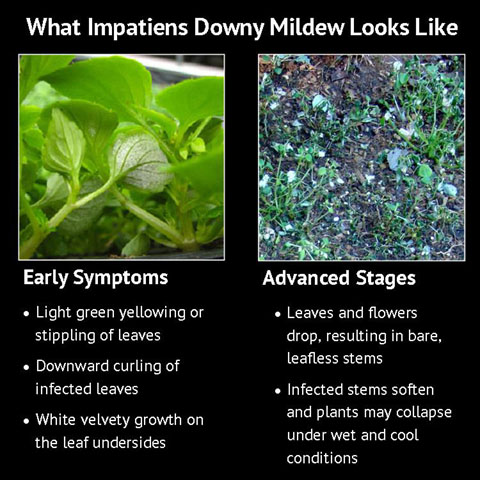Last year, we encountered a widespread, extremely destructive disease called Impatiens Downy Mildew, affecting Impatiens walleriana (common impatiens). It is an aggressive and easily spread disease that causes the plant to lose its leaves and eventually die. Some of you may have encountered this at your property last summer. Downy mildew is not easy to detect in its early stages, so by the time you know you have it, it’s likely to have infected all of your impatiens. The disease has impacted impatiens in other parts of the United States for several years now, but first became a problem here during the 2012 planting season.
Infected plants will develop yellow spots on the leaves and appear to be unhealthy. An examination will reveal white spores on the underside of the leaves, which soon will begin to drop from the stems. The disease can be controlled in a greenhouse environment with use of fungicides, but the effects of the fungicides lessen with time. Impatiens that appear healthy upon purchase can deteriorate quickly once they’re planted at home. Established, downy mildew spores can be spread by the wind, blowing from site to site easily infecting other impatiens. Fortunately, the disease does not spread to other plant varieties, including New Guinea impatiens. Because the disease is so difficult to prevent and control, the only real solution seems to be not planting impatiens.
Alternatives
Fortunately, there are many common shade-loving annuals that make great alternatives to planting impatiens. New Guinea Impatiens, Reiger Begonias, Coleus, Caladium, Tuberous Begonia ‘Non-Stop’ varieties, Impatiens Hybrids ‘Fusion’ series are just a few of the wonderful alternatives to select from
Perennials are also an excellent alternative to seasonal annuals. Although the upfront cost may be higher, selecting plants that return each year provides a lower-maintenance, longer-lived, sound solution. Two perennial groundcovers we recommend are Creeping Vinca, covered with periwinkle blue flowers in spring, and Lamium, a lower-growing groundcover with interesting foliage and lovely white, pink or purple flowers. There are many shade-loving perennials to choose from that bring color and are suited to different soil types. Dry shade areas will benefit from tough Hosta like ‘June’ and ‘Paradigm’, with fancy foliage and lavender colored blooms. Wet areas will allow Astilbe to thrive; ‘Purple Candles’ has bold fuchsia-pink flowers, while ‘Peach Blossom’ has delicate peach-pink. Well-drained conditions would work perfectly for Coralbells like ‘Caramel’ and ‘Tiramisu’, which have beautiful leaves of orange, purple, yellow and green.
Impatiens have been a garden staple for many years and it is unfortunate that the disease has decimated our area. We look forward to the day when a downy mildew-resistant strain of Impatiens walleriana is developed and we can confidently bring them back.

